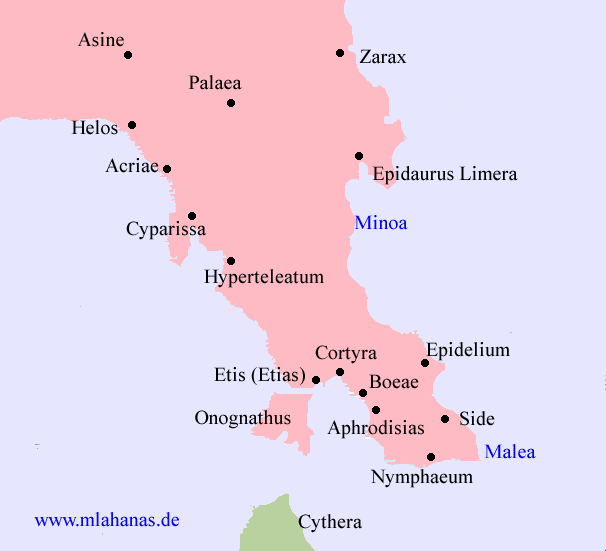.

Epidelium or Epidelion (Ancient Greek: Ἐπιδήλιον), called Delium or Delion (Δήλιον) by Strabo,[1] was a small town on the eastern coast of ancient Laconia, situated within the territories of Boeae, at the distance of 100 stadia from Cape Malea, and 200 from Epidaurus Limera. Epidelium was a sanctuary of Apollo, erected at the time of the Mithridatic War, when a wooden statue of the god floated to this spot from Delos, after the devastation of the island by Metrophanes, the general of Mithridates VI.[2][1]
Its site is located north of the modern Agios Phokas.[3][4]
Epidelium in Laconia, Greece
On the voyage from Boeae towards the point of Malea is a harbor called Nymphaeum, with a statue of Poseidon standing, and a cave close to the sea; in it is a spring of sweet water. There is a large population in the district. After doubling the point of Malea and proceeding a hundred stades, you reach a place on the coast within the frontier of the Boeatae, which is sacred to Apollo and called Epidelium.
For the wooden image which is now here, once stood in Delos. Delos was then a Greek market, and seemed to offer security to traders on account of the god; but as the place was unfortified and the inhabitants unarmed, Menophanes, an officer of Mithridates, attacked it with a fleet, to show his contempt for the god, or acting on the orders of Mithridates; for to a man whose object is gain what is sacred is of less account than what is profitable.
This Menophanes put to death the foreigners residing there and the Delians themselves, and after plundering much property belonging to the traders and all the offerings, and also carrying women and children away as slaves, he razed Delos itself to the ground. As it was being sacked and pillaged, one of the barbarians wantonly flung this image into the sea; but the wave took it and brought it to land here in the country of the Boeatae. For this reason they call the place Epidelium
References
Strabo. Geographica. viii. p.368. Page numbers refer to those of Isaac Casaubon's edition.
Pausanias. Description of Greece. 3.23.2. , et seq.}}
Richard Talbert, ed. (2000). Barrington Atlas of the Greek and Roman World. Princeton University Press. p. 58, and directory notes accompanying.
Lund University. Digital Atlas of the Roman Empire.
This article incorporates text from a publication now in the public domain: Smith, William, ed. (1854–1857). "Epidelium". Dictionary of Greek and Roman Geography. London: John Murray.
| Ancient Greece
Science, Technology , Medicine , Warfare, , Biographies , Life , Cities/Places/Maps , Arts , Literature , Philosophy ,Olympics, Mythology , History , Images Medieval Greece / Byzantine Empire Science, Technology, Arts, , Warfare , Literature, Biographies, Icons, History Modern Greece Cities, Islands, Regions, Fauna/Flora ,Biographies , History , Warfare, Science/Technology, Literature, Music , Arts , Film/Actors , Sport , Fashion --- |
Retrieved from "http://en.wikipedia.org/"
All text is available under the terms of the GNU Free Documentation License


